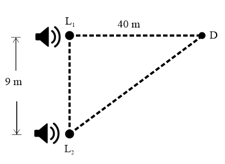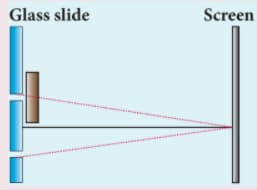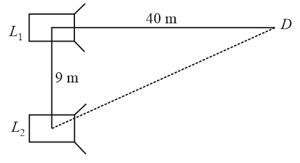Interference
Interference: Overview
This topic covers concepts, such as, Interference of Waves, Condition for Constructive Interference, Coherent Sources of Light & Observing Interference of Light Waves etc.
Important Questions on Interference
In Young’s double slit experiment, the two slits 0.15 mm apart are illuminated by monochromic light of wavelength 450 nm. The screen is 1.0 m away from the slits.
(a) Find the distance of the second (i) bright fringe, (ii) dark fringe from the central maximum.
Which of the following expressions is/are correct for Young’s experiment?
(i) condition for bright fringes
(ii) condition for dark fringes
ii) fringe width
A thin slice is cut out of a glass cylinder along a plane parallel to its axis. The slice is placed on a flat glass plate as shown in figure. The observed interference fringes from this combination shall be

Two coherent monochromatic light beams of intensities and are superposed. The maximum and minimum possible intensities in the resulting beam are
We can not observe interference pattern of microwaves.
What are the safety precautions should be for interference of the light waves?
Which is following statement is correct?
When two waves with the same frequency and constant phase difference interfere
Two loudspeakers and driven by a common oscillator and amplifier are arranged as shown. The frequency of the oscillator is gradually increased from zero and the detector at records a series of maxima and minima. If the speed of sound is , then the frequency at which the first maximum is observed is

An observer receives waves directly from a source of sound distant in a big hall. He also receives waves reflected from the mid-point of high ceiling. The wavelength of sound for constructive interference to take place between two waves, must be
The maximum intensity of fringes in Young's experiment is . If one of the slit is closed then, the intensity at that place becomes . Which of the following relations is true?
One of the Young's double slits is covered with a glass plate as shown in the figure. The position of central maxima will:

How do source and image behaves as coherent sources?
How does wavefront division provide coherent sources?
Two speakers connected to the same source of fixed frequency are placed apart in a box. A sensitive microphone placed at a distance of from the mid-point along the perpendicular bisector shows maximum response. The box is slowly rotated till the speakers are in line with the microphone. The distance between the mid-point of the speakers and the microphone remains unchanged. Exactly maximum responses (including the initial and last one) are observed in the microphone in doing this. The wavelength of the sound wave is,
The loudspeakers and driven by a common oscillator and amplifier are set up as shown in the figure. As the frequency of the oscillator increases from zero, the detector at recorded as a series of maximum and minimum signals. What is the frequency at which the first maximum is observed? (Speed of sound )

are two coherent sources of sound having no initial phase difference. The velocity of sound is . No minima will be formed on the line passing through and perpendicular to the line joining if the frequency of both the sources is

A monochromatic light of is incident on two slits separated by a distance of . The interference pattern is seen on a screen placed at a distance of from the slits. A thin glass plate of thickness and refractive index is placed between one of the slits and the screen. Find the intensity at the centre of the screen, if the intensity there is in the absence of the plate. Also find the lateral shift of the central maximum (in ).
